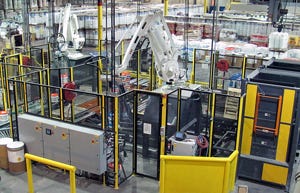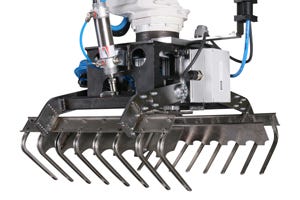Robotic palletizing challenge
As one of America's largest producers of granular calcium hydrochlorite for swimming pools and spas, Arch Chemicals' plant in Charlestown, TN, faced a unique challenge: how to improve speed, efficien
xArch 2.jpg
cy and ergonomic safety when palletizing a range of containers rolling down two lines. Arch Chemicals Inc. is a global biocides company with more than $1 billion in annual sales, and its HTH and related brands of pool treatments are among the most popular in the world.
"The old mechanical system, which could handle only one container at a time, just wasn't cutting it," says Dave Sauer, the plant's process control engineer. In addition, vacuum pick-up, which is the process used in many robotic palletizing operations, could not handle its various-sized containers, which range from 2-lb pails to 275-lb drums.
That's when Arch Chemicals looked to Automation Project Group (APG) for a solution.
"We had worked with APG in the past," says Sauer. "We chose them this time for their end-of-arm tooling for the robots. The old mechanical system could handle a maximum of nine pails per minute. Our test this time was based on how fast our filling equipment could run, which gave us how many items we needed to palletize every minute."
Two robotic palletizing cells
Arch Chemicals has two similar lines, so APG installed two robotic palletizing cells, each incorporating an ABB Inc. model IRB 660 robot. "We have an ABB robot in the plant, so we were pleased that APG suggested the ABB units for the new installation," says Sauer. Specifically designed for palletizing operations, the IRB 660 industrial palletizing robot combines superior speed and reach with high payload capacity of up to 550 lb, making it ideal for palletizing Arch Chemicals' range of package sizes.
The IRB 660 robot has integrated power, signals, field bus and air routed to the wrist, and its IP67 protection rating makes it robust in harsh environments.
Containers are delivered into each of the robot cells on a dual-chain conveyor, where they are picked up by the robot and placed onto a pallet. The larger containers are too heavy to use vacuum grippers, so the robots are equipped with a strong end-of-arm gripper designed by APG.
The gripper consists of a bottom metal plate and a pair of vertical forks with a stationary back plate. The robot slides the bottom plate beneath the container after which the forks descends around the container and pull it against the back plate. The robot arm then transfers the container to the pallet and the procedure is reversed. The bottom plate actually supports the load, while the forks and back plate stabilize it and keep it from shifting during transport.
Depending on the size of containers bein
xArch 1.jpg
g run, the containers are stacked from four to five layers high on the pallets.In production, a container enters the palletizing cell and travels to the lifting position. It is then raised as described. The next container moves into position, and the robot lowers the upper container onto the lower one, and then lifts them both into the air. This process continues until a complete stack of containers is assembled, after which the stack is shifted to the pallet.
Grippers make adjustments
One of the keys to this operation is that the grippers adjust themselves to handle the different size containers automatically using what AGP calls its "servoless servo automatic setup" system. To initiate a change, the operator selects the product he is going to run on the specific robot cell's HMI. The controls then adjust the spacing of the forks relative to the vertical back plate so that they fit tightly around the containers.
In this procedure, the controls unlock the forks, after which the robot arm pushes them against a bar set into side of the cell until the forks move back to a zero position. The robot arm then moves the forks around behind this bar and pulls them open to the proper spacing for the container that is going to be run. The controls then lock the forks into this position.
As part of the selection process, the controls also automatically set the number of containers assembled in each stack and the number of stacks to be placed on the pallet. The robots are equipped with photo eyes and sensors that can even discern a wrong pallet.
"The real challenge for APG was that space at the end of the two lines was at a premium," Sauer explains. "APG did a great job with its designs. With our earlier mechanical system, we could not handle the small containers; now we can do all sizes."
The robotic arm sits atop a 6-ft pedestal that gives it greater reach for its simple-yet-articulate end-of-arm tooling, says Sauer.
Calcium hydrochloride makes for a pretty corrosive environment, which means regular equipment purging. However, the ABB robotic was sufficiently robust to handle this difficult environment.
Besides improving productivity, the APG solution also removed a major ergonomic challenge. With the earlier mechanical system, Arch had to hand-stack at least 15 percent of the pallets.
Now, all of the containers are robotically palletized. "Mostly the system goes 24/7, though naturally we inspect it weekly and shut it down for one or two days for regularly scheduled maintenance," Sauer says. "There was a lot of skepticism at first but now most of our production people really like the system.
"ABB has been here to the plant for preventative maintenance, and we have been very pleased with their service and expertise. And the APG robotic palletizing system has helped us reduce repetitive strain injuries and increase safety. We feel we have a long-term solution."
ABB Inc., 248/391-9000. www.abb.com/robotics
Automation Project Group, 519 746 2537. www.automationprojectgroup.com
SIDEBAR
Grippers are the key
In an industrial robotic palletizing operation, the robotic arm provides the muscle, but the end effectors or grippers provide the dexterity. Much in the way that a baseball pitcher's arm provides the velocity on a ball, but his fingers impart the movement, the grippers are the devices that actually pick up the packages. While there are numerous gripper designs, they generally fall into three main categories: vacuum, claws and clamps.
Vacuum is the simplest and pr
xSidebar Vacuum.jpg
obably the most widely used gripper technology. It is typically used in applications where the package is not too heavy or too irregular for the vacuum to be maintained. In this process, a number of cups are present to distribute the load over the top of the package, but the vacuum is applied only to the cups that are actually contacting the package. Thus, vacuum grippers can handle a range of package sizes without requiring changes.
Claws generally consist of steel fingers that pass under the package, while a pad descends on top of the package to hold it in pl
xSidebar Claw.jpg
ace. The system may have one set of fingers that enter from one side or there may be two sets of fingers-one from each side. The installation at the Scotts bird seed plant described on page 48 of this issue, uses a single set of fingers to pick up cases of bird seed. Fingers were selected for this application because the cases can weigh up to 60 lb.
Clamp systems c
xSidebar clamp.jpg
onsist of vertical plates that are pushed in against the sides of cases. They generally have short fingers or hooks at the bottom that help support the cases, and they may have rubber pads on the sides to provide additional friction.
Photos of the grippers were supplied by ABB Inc.
About the Author(s)
You May Also Like


